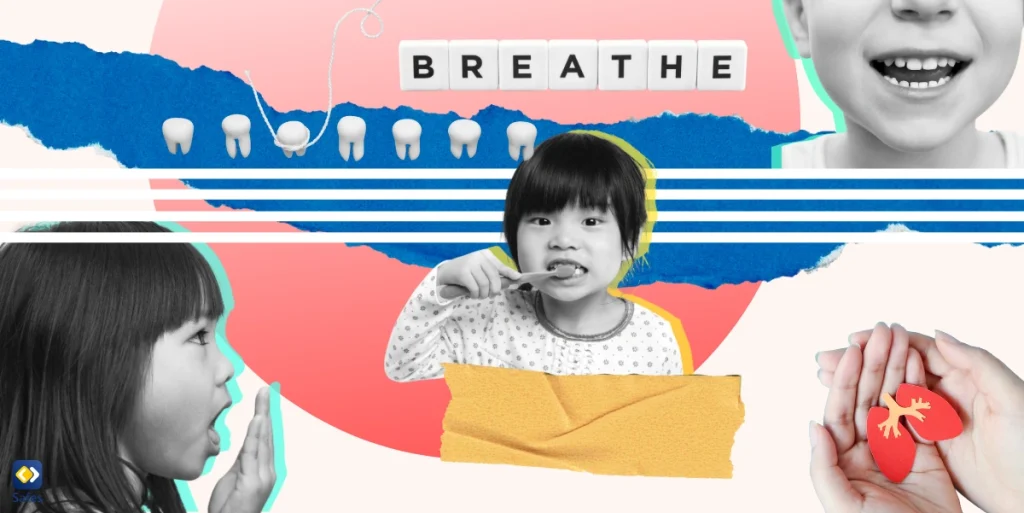Mouth breathing can seem harmless but can lead to various health complications, particularly in children. Thus, it’s crucial to understand the root causes and potential solutions to help stop mouth breathing. This guide aims to educate parents on how to stop mouth breathing in their children, covering the key aspects like causes, symptoms, effects, and strategies to address the issue.
Download and Start Your Free Trial of the Safes Parental Control App
Understanding Mouth Breathing
Mouth breathing is a condition where a person breathes through their mouth instead of their nose. This habit might seem trivial, but it can significantly affect a person’s health and well-being, especially in children.
Nasal Breathing Vs. Mouth Breathing
To understand the impact of mouth breathing, we first need to comprehend the difference between nasal and mouth breathing. When we breathe in through our nose:
- The inhaled air gets filtered by tiny hairs in our nostrils, called cilia, which remove allergens and pollutants.
- The air is warmed and humidified, which is beneficial for our lungs and throat.
- We inhale air at the right pressure, which aids in optimal oxygen extraction.
On the other hand, mouth breathing:
- Lacks the filtration mechanism, allowing toxins to enter our lungs directly.
- Dries out the mouth and throat due to lack of humidification.
- May cause over-breathing, leading to a reduction in carbon dioxide levels in our blood.
Impact of Mouth Breathing on Children
Mouth breathing can have detrimental effects on children’s physical and mental development. It can lead to developmental issues, sleep disorders, and cognitive problems. Hence, it’s crucial to understand how to stop mouth breathing in children.
Physical Impact
Persistent mouth breathing can alter a child’s facial structure, leading to uneven face and jaw symmetry, crooked teeth, overcrowded mouth, and persistent pain.
Cognitive Impact
Mouth breathing can also lead to cognitive issues. It can cause problems with concentration, disrupt emotional and social development, lead to misdiagnosis of ADD and ADHD, and affect school performance.

Identifying Mouth Breathing: Signs and Symptoms
Observation is key when it comes to identifying mouth breathing in your child. Look out for the following signs:
- Persistent open-mouthed look
- Snoring
- Difficulty speaking
- Dry mouth and cracked lips
- Frequent cavities and tooth decay
- Problems sleeping at night
- Trouble concentrating at school
Causes of Mouth Breathing
Several factors can contribute to mouth breathing. These include:
- Blocked nasal passages due to allergies or anatomical issues
- Problems with mouth and bite structure
- Bad habits such as thumb sucking or long-term use of pacifiers
- Underlying conditions like sleep apnea
Understanding these causes is the first step in learning how to fix mouth breathing.
Strategies to Stop Mouth Breathing
Addressing mouth breathing requires a multi-pronged approach. Here are some strategies to consider:
Breathing Exercises
Breathing exercises can help retrain your child’s breathing patterns, encouraging them to breathe through their nose rather than mouth. There are exercises to help your child stop mouth breathing in different situations, such as while talking or playing.
Dental Appliances
In some cases, a dental appliance may be used to help correct mouth structure issues contributing to mouth breathing.
Consultation with Healthcare Professionals
If mouth breathing persists, consultation with a pediatrician, dentist, or ENT specialist is advisable. They can help identify underlying causes and suggest appropriate treatment options.
Role of Technology in Ensuring Healthy Habits
Today, technology can play a significant role in ensuring healthy habits in children. The Safes parental control app, for instance, can help you monitor your child’s screen time, promoting healthy sleeping patterns and potentially reducing instances of mouth breathing while sleeping.
Safes can also help you with filtering harmful content, apps, and search keywords. With Safes, you can monitor your child’s social media use and receive alters if ever they come across potentially harmful posts or messages. These tools can help you remove the negative aspects of the internet and, as a result, support your little one’s mental and physical health.
You can use Safes to monitor your child’s phone, tablet, and computer. So, one app fits all! Feel free to download Safes from our website, Google Play, or App Store. Begin your free trial with Safes and access tools that promote better breathing habits.
How to Stop Mouth Breathing: Conclusion
As we discussed throughout this article, understanding how to stop mouth breathing is crucial for your child’s well-being. By understanding the causes, signs, and symptoms, you can take proactive measures to address this issue. When it comes to your child’s health, early intervention is critical. Monitor your child’s breathing habits and consult healthcare professionals for personalized advice and treatment options.
Your Child’s Online Safety Starts Here
Every parent today needs a solution to manage screen time and keep their child safe online.
Without the right tools, digital risks and excessive screen time can impact children's well-being. Safes helps parents set healthy boundaries, monitor activity, and protect kids from online dangers—all with an easy-to-use app.
Take control of your child’s digital world. Learn more about Safes or download the app to start your free trial today!




